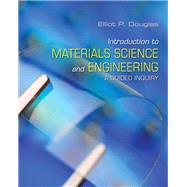
Note: Supplemental materials are not guaranteed with Rental or Used book purchases.
Purchase Benefits
What is included with this book?
Preface
Part I: Introduction
Chapter 1: What is Guided Inquiry?
1.1 First Law of Thermodynamics
1.2 Active Learning
Chapter 2: What is Materials Science and Engineering?
2.1 Types of Materials
2.2 The MSE Triangle
Part II: Atomic and Molecular Structure of Materials
Chapter 3: Bonding
3.1 Electronegativity
3.2 Primary Bonds
3.3 Non-Bonding Interactions
Chapter 4: Atomic Arrangements in Solids
4.1 Crystalline and Amorphous Materials
4.2 Unit Cells
4.3 Miller Indices
4.4 Planes and Directions in Crystals
4.5 Crystalline Defects
4.6 Ceramic Crystal Structures
4.7 Defects in Ceramic Crystals
4.8 Determining Crystal Structure: Diffraction
Chapter 5: The Structure of Polymers
5.1 Molecular Structure
5.2 Molecular Weight
5.3 Polymer Crystals
5.4 The Glass Transition
Chapter 6: Microstructure: Phase Diagrams
6.1 Defining Mixtures
6.2 Isomorphous Binary Phase Diagrams – The Lever Rule
6.3 Isomorphous Binary Phase Diagrams – Microstructure
6.4 Eutectic Phase Diagrams – Microstructure
6.5 Eutectic Phase Diagrams – Microconstituents
6.6 Peritectic Phase Diagrams
6.7 Intermetallic and Ceramic Phase Diagrams
Chapter 7: Diffusion
7.1 Diffusion Mechanisms
7.2 Diffusion Calculations: Fick’s Laws
Chapter 8: Microstructure: Kinetics
8.1 Nucleation and Growth
8.2 Heterogeneous Nucleation
8.3 Equilibrium vs. Nonequilibrium Cooling
8.4 Isothermal Transformation Diagrams
8.5 Continuous Cooling Transformation Diagrams
Part III: Properties and Uses of Materials
Chapter 9: Mechanical Behavior
9.1 Stress-Strain Curves
9.2 Bond-Force and Bond-Energy Curves
9.3 Strength of Metals
9.4 Strengthening Mechanisms for Metals
9.5 Structure-Property-Processing Relationships in Steel
9.6 Polymer Properties
9.7 Properties of Ceramics
9.8 Fracture
9.9 Fatigue
9.10 Hardness
9.11 Viscoelasticity
9.12 Composites
Chapter 10: Materials in the Environment
10.1 Electrochemistry: How Does a Battery Work?
10.2 Corrosion of Metals
10.3 Oxide Formation
10.4 Degradation of Polymers
Chapter 11: Electronic Behavior
11.1 Band Structure of Materials
11.2 Electronic Properties
11.3 Conductors
11.4 Semiconductors
11.5 Solid-State Devices
Chapter 12: Thermal Behavior
12.1 Heat Capacity
12.2 Thermal Expansion
12.3 Thermal Conductivity
Chapter 13: Materials Selection and Design
13.1 Ranking Procedures
13.2 Ashby Plots
The New copy of this book will include any supplemental materials advertised. Please check the title of the book to determine if it should include any access cards, study guides, lab manuals, CDs, etc.
The Used, Rental and eBook copies of this book are not guaranteed to include any supplemental materials. Typically, only the book itself is included. This is true even if the title states it includes any access cards, study guides, lab manuals, CDs, etc.